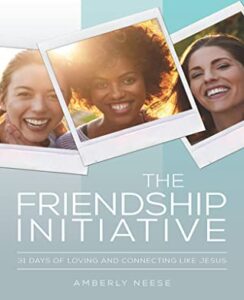The Friendship Initiative: 31 Days of Loving and Connecting Like Jesus
Amberly Neese
Abingdon Press
Published May 4, 2021
Amazon | Bookshop | Goodreads
About The Friendship Initiative
We long for connection. Despite faster internet connections, better WiFi hotspots, and more ways to stay connected than ever before, our lives still feel less and less connected. We desire healthy friendships but feel less equipped to make and foster them. In THE FRIENDSHIP INITIATIVE by Amberly Neese, we dive into the friendships and connections Jesus made in the Bible and discover 31 keys for building relationships. Each devotion includes Scripture, a devotional reflection, practical application ideas, and suggestions for reflection and prayer.
Keys for relationship building include: exercising grace asking/answering questions having compassion exercising humility being present reaching out to those who are different and more Readers will…
Find encouragement and practical help for connecting with others in their everyday lives. Focus on loving others as Jesus did. Discover 31 Keys for building relationships.
My Review
I kind of have mixed feelings about this book.
I liked the discussion questions best. They were really deep and often asked me to examine things that I definitely needed to look at in my life. So I felt like those were really right on for me and very revealing about what’s happening in my life and my heart.
The author’s personal stories were good, too. They were entertaining and fun, but they explored real issues. I think that style would make a lot of readers feel at ease and feel connected to the author.
The scripture verses in each chapter usually involved Jesus interacting with someone and then discussed a facet of what he did and why we should emulate that. I thought those were good, usually pretty basic things, pretty solid stuff. It’s good to be reminded of those things.
Some of the examples and the personal stories connected the scripture examples directly to friendship and how friendships and connections are made. But others were kind of more personal or more specifically for a person’s relationship with God– which are great things to learn about, I just felt like there were chapters that didn’t relate to friendship really, and that made me wonder why that chapter was included in this study? I felt like they needed a stronger connection to helping foster friendship and connections to be in the book.
Another thing I also thought was interesting was the way the book focused so much on stories from the Bible in which Jesus had these one-off encounters with people. Each story selected was a powerful story. I guess sometimes it felt like the book was equating being friendly with friendships. I think I expected the study to maybe focus more on examples of friendship from the Bible or maybe Proverbs about relationships? I’m not sure.
The thing that drew me to the book was the idea that I could learn how to make deeper connections with people or to have healthier friendships. I think the discussion questions really nailed me on some things. I think I wanted that same level of depth from some other parts of the book, though.
All in all, I feel like this is a pretty solid study for someone maybe newer to faith or looking for some core lessons on how Jesus treated people.
Content Notes
Recommended for Ages 14 up.
Representation
I think this author is white, but I’m not sure.
Profanity/Crude Language Content
None.
Romance/Sexual Content
None.
Spiritual Content
Based on Bible verses and assumes the reader is pursuing a Christian life.
Violent Content
None.
Drug Content
None.
Note: This post contains affiliate links, which do not cost you anything to use, but which help support running this blog. I received a free copy of THE FRIENDSHIP INITIATIVE in exchange for my honest review.
